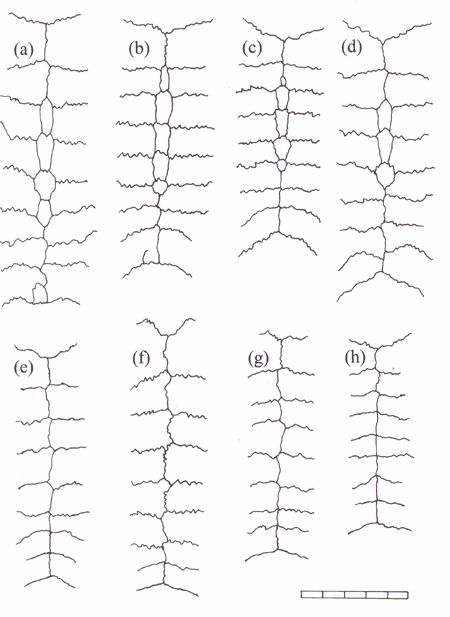

Thomson, S. and Georges, A. (1996). Neural bones in chelid turtles. Chelonian Conservation and Biology 2:82-86.
Neural bones are median elements of the turtle carapace overlying the dorsal vertebrae. The ancestral condition is thought to be a series of eight relatively narrow, hexagonal neural bones with short sides anteriorly placed, forming a continuous series from the nuchal bone anteriorly to the first suprapygal posteriorly (Pritchard, 1988), a condition retained in many extant species of the Bataguridae, Emydidae and Cheloniidae, but frequently modified, e.g. by elimination of elements at the ends of the series, formation of one or more octagonal elements, or alteration to a series of hexagons with short sides posteriorly.
Materials and Methods Specimens were obtained from various collections, skeletonized, and the scutes removed to reveal the arrangement of bony elements. Longitudinal and transverse sections of shell vertebrae and associated neurals and pleurals were prepared with a diamond saw for the chelid turtles Chelodina longicollis, C.oblonga, Emydura sp. aff. krefftii (Fraser Island), Emydura sp. aff. subglobosa (Sleisbeck) and Elseya dentata and for the trionychid Aspideretes hurum. Where exposed neurals were present, sections were arranged to transect one or more of them. Sections were examined under a microscope to ascertain the presence of sutures between the various elements. |

Figure 1. Comparison of the neural region of the dorsal carapace of the sibling species pair Elseya sp. aff. latisternum (Manning) [a to d] and Elseya sp. aff. latisternum (Bellinger) [e to h]. Scale = 5 cm. a. AM 123042 b. QM 59290 c. QM 59289 d. AM 123040 e. AM 138387 f. AM 138388 g. UM 02016 h. UM 02017
Specimens Examined.-All unregistered specimens that remained intact following examination were lodged with the Queensland Museum. The sectioned specimens remain in the collection of the University of Canberra. Names given to undescribed species follow those of Georges and Adams (1992). Abbreviations: AM, Australian Museum; QM, Queensland Museum; NTM, Museums and Art Galleries of the Northern Territory; UM, University of Michigan field series; UC, University of Canberra; PCHP, Peter C. H. Pritchard personal collection.
|